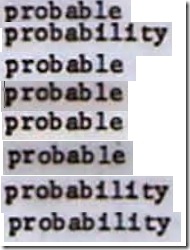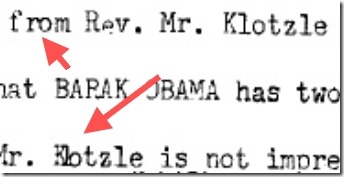I’m not an expert on typewriters, but I own one and I’ve used one since at least 1967 when I took typing in high school. There are forensic document examiners that specialize in typewriters, but so far as I know, none are birthers. One birther, Paul Irey, says he was a typist, and that at one point in his career he used a typewriter for publishing. He is what birthers call “an expert.” Neither of us would ever make the cut to testify in court. But I’m a blogger, and I can write about anything.
In basic terms, a typewriter is a mechanical device that works when a type slug bearing a raised character, strikes an inked ribbon, that in turn strikes paper, leaving the imprint of a letter or symbol. A mechanism in the typewriter moves the paper after each strike to position it to receive the next letter. In the best of worlds, the typewriter would produce results like this:
What we see above is perfectly-aligned simulated typewriter printing with additional grid lines to show how each letter is perfectly centered within a conceptual horizontal region (typically one tenth of an inch wide).
The print slug sits at the end of a type bar that is swung at the paper. There is some play in that mechanism, so an additional piece of hardware is used to keep the spacing uniform; it’s called a “type bar guide.” The type bar travels through a narrowing wedge defined by the guide so that it falls dead center within the tenth of an inch region, or should. One typewriter repair manual puts it this way:
The type bar guide is an important factor in alignment. If the sides of the guide are too far apart, there will be a lot of play in the bars as they enter the guide. A summary of all the bars should be made and the type bar guide closed up by means of set screw to suit the majority of the type bars.
Type bars and guides are subject to wear:
[There is] wear on the type bar due to the constant chopping action of the type bar on the type guide at the moment of the blow of the type on the platen. No matter how hard the surface of the type guide or bar may be this constant chopping will wear the guide and as a consequence destroy the alignment.
Rudolph P. Brandt – 1926
So what does this have to do with Obama’s certificate? As I said in Part 1, birthers believe that the White House image is a composite of images from other certificates, digitally placed on the page and that differences from perfect-world horizontal spacing indicate fakery rather than normal typewriter operation. To be fair, birthers don’t say that all horizontal variation indicates fakery; they assert that horizontal variation that makes two letters overlap to any extent indicates fakery. This is, however, an arbitrary criterion. A little measurement indicates that a horizontal variation of just .03” is enough to create overlap with some letter combinations at 10 characters per inch. There is nothing to make a horizontal play of .03” less possible than a horizontal play of .02”.
Some letters are wider than others, for example “m” is wider than “i” which means that letters such as “m” can overlap other letters with a smaller standard of variation than an “i.” For example, in the following example letter pairs “ob” and “ab” do not contain overlaps, but the if the letters “WM” were placed on those type bars, they would have overlapped.
A scientific approach would be to compare examples of unquestioned typewritten document images similar to the White House image. This is a little difficult because the kinds of differences we are dealing with may involve the defects/wear/alignment of a particular typewriter and unless we have comparison samples from that particular typewriter, some guesswork is inevitable.
So let’s first establish that typewriters do not have perfect horizontal alignment, and for that purpose, I give this image taken from Jerome Corsi’s PhD thesis1 (Page 6):
You can see how the letter “t” is out of alignment. It doesn’t actually overlap, by the way. (The halo effect is in the original scan.) Something else to note is that the letter “y” in a typewriter font is a wide letter with the descender appearing as far to the left as possible. That means that it takes minimal horizontal error to make a letter overlap the following “y.”
Birthers have argued in comments on this blog both that consistent variation (for example “it” above) is a sign of fakery and that inconsistent variation is is a sign of fakery. (It has also been argued that the presence of “layers” in the PDF are a sign of fakery and that having too few layers is a sign of fakery. This points again to the lack of scientific method where speculation replaces evidence.) So which is normal, consistent variation or inconsistent variation? The answer is “both.” Look at the following samples from Corsi’s thesis (horizontally aligned on the letter “r”).
What you see is a tendency for the letters “ob” to be close together, but not always. Sometimes it looks like “rob” and sometimes “r ob.” The first one is pretty normal, but the third, sixth and eighth ones not so much. There is both consistent and random variation. From what I see on this machine, it looks like some of the type bars are a little bent and that the type bar guide is a little far open.
Horizontal variation also can be caused by the carriage (the part of the typewriter that holds and moves the paper). If the carriage doesn’t move precisely, then the paper will not be positioned properly to receive the imprint, no matter how precisely the type bar is positioned. Here’s an example from the Barack Obama Sr. FOIA file (PDF Page 6) from the state department (and this is probably a good time to think about how well government agencies maintain their office equipment):
In this example, we see what looks like an adjustment problem resulting in the overlap of the letters “ro”; as well as a manual insertion of the letter “l” in the word “Klotzle.”
Stay tuned for the next episode “Forensic document stuff (Part 3—Zoom!).”
1This document is not available on the Internet, but you can order a copy on microfilm from the Harvard University Library.








Wow, so Corsi’s thesis was fraudulent!
Typewriters are a 19th century technology. I am still amazed at the mental gymnastics people go through, to find some hint of forgery, or something amiss – anything amiss.
I don’t care where Obama was born, and I don’t care who his father was. This election is about the 1st Amendment, universal healthcare like Israel has, and reproductive freedom.
I have one thing to say to the Denialists: Obama will be re-elected. Better get used to it. And I hope Orly Taitz has a nervous breakdown. After that, she should go live in a West Bank settlement, with her soulmate Avigdor Lieberman.
I’m not going to vote GOP, no matter how much they love Israel, because the rest of their platform is odious, and the conservative movement is filled with
crackpotspsycho-ceramics.questions doc:
are there ever variations due to the typist? the hunt and peck type as opposed to a professional? or is it all dependent on the machine?
since i have not been here from the beginning, do you have a “where/how you began this blog” link?
tia and thanks for all you do here
Carriage-movement spacing errors will largely be a function of typing speed. Fast typing can ‘outrun’ the carriage advance. One would expect that a hunt-and-peck typist’s spacing would be more even on a given machine that a fast typist’s. Also, I would expect the worst spacing anomalies from an inexperienced person typing quickly; he or she would also have key-jams, while a professional’s fast strokes would be more evenly-spaced to avoid jams.
I am old enough to have seen thousands of examples of hand-typed text, and there is nothing about any of the BHO documents that looks even slightly atypical.
Didn’t mean to speak for Doc, just to save him some keyboard time. Anyone have anything to add?
Or the typewriter (manual and electric).
I would expect there are even differences by the same typist. Even a slow typist can produce variations in certain letter combinations.
BTW, sometime ago NBC displayed various BCs from Hawaii. To my untrained eye it looks as thou Hawaii hospitals switched to electric typewriter in the late 70’s/early 80’s.
https://nativeborncitizen.wordpress.com/2010/10/24/evolution-of-the-hawaiian-long-form/
You are absolutely right. I am a very fast typist (years of writing news under deadline) and it was very easy to out pace a manual typewriter…..especially if it was out of adjustment.
Add to that jamming and overstriking keys in the guide and it could look pretty raggedy.
Either that or he was really born in Kenya. Your choice.
A little off topic, but still relevant:
http://www.rawstory.com/rs/2012/03/23/obama-meets-hawaiian-woman-asks-to-see-her-birth-certificate/
Also an old article I just found on wikinews:
http://en.wikinews.org/wiki/Champaign,_Illinois_mayor_doubts_Obama%27s_natural-born_citizenship;_local_politicians_divided_on_whether_mayor_should_resign
thanks guys – i figured there might be anomalies depending on the typist – and typing info on a form is not the same as typing text – it’s all stop and go –
thanks again
Birthers exist in a world where the past is perfect. Where a scanner can’t make an imperfect copy, where a typewriter works as well as it did 15 years after it was purchased, and that all these machines are operated by perfect individuals that never make a mistake.
This world never existed.
Some hunt and peck typists hit the keys with excessive force which can cause the carriage to jump 2 spaces on some machines. My experience is that government clerical jobs require minimum typing speed, so who ever did the birth certificate most likely was an experienced typist.
You can speak for yourself! As you can see by the new article, I have been rather busy.
There have been several “origins” articles including:
http://www.obamaconspiracy.org/2008/12/beginning/
http://www.obamaconspiracy.org/2008/12/whats-this-web-site/
http://www.obamaconspiracy.org/2009/01/the-audacity-of-blog/
I got a brand new typewriter as a HS graduation present and took it to college. I was a poor to average typist at the time. After 6 months of typing on a teletype machine inputting programs, I couldn’t use the typewriter for quids. I typed too fast, and the jams were constant. It was well worth it to get someone else to type my assignments for me. In payment, she got to keep the typewriter.
Having learned on the manual typewriters, and used them, there was always a variation not only between typists but between typewriters. Some had “soft keys” some had “hard,” where you had to really “pop” the keys to get it to move. That’s besides the alignment problems, jams, ribbons getting faded or twisting, and someone forgetting to clean the the type. So any “variations” that people see are not evidence of forgery, just evidence of a busy office.
I don’t think you’re correct when you say “Some letters are wider than others”. In my experience, all letters on a typewriter are the exact same width. You can see that in your picture of the word “community” where both “m”s, the “n” and even the “i” are the same width.
There are two width to look at, one is the width that is taken up by the character and surrounding whitespace, which on most typewriters, unless they use proportional spacing, is constant, and the width of a given character. The i typically takes up far less space than the m whose edges are closer to neighboring characters. Thus, if an ‘m’ is slightly off center, it is more likely to overlap with a neighboring character than an ‘i’ for instance.
The “i” would be just as likely to overlap, it’s just that with the “m” it would be more noticeable since there’s more ink in the space with the “m”. If that’s what Doc meant, maybe he should clarify that in the article for accuracy.
No it wouldn’t. We are talking about the glyph not the character space here.
Most typewriters are fixed spacing, usually 10 characters per inch. That means that there is a one tenth of an inch space for a glyph to fit into. The glyph for the letter ‘m’ takes up most of that one tenth of an inch. The glyph for the letter ‘i’ takes up very little of that one tenth of an inch.
Now, if you type the word ‘bummer’ and the second ‘m’ is a bit out of alignment to the left, its character space will intrude on the character space occupied by the first ‘m’ and the likelihood that the glyph will overlap is very high.
If you type the word ‘wimper’ and the ‘m’ is a bit out of alignment to the left, its character space will again intrude on the character space occupied by the ‘i’, but the likelihood that the glyph will overlap is much less.
The character space overlaps in both cases, but since the actual glyph occupies more or less of that character space not all glyphs will visually touch each other.
My point is that Doc should clarify what he meant when he said “Some letters are wider than others”. It’s not true. All characters on the typewriter take the same amount of horizontal space whether or not the entire space is filled with black ink. Especially when he said that “m” is wider than “n”. It isn’t.
You appear to be confusing pitch and type size. Pitch is the number of letters – be they “m”, “w” or “i” will take ten spaces (for pica spacing or 12 for elite) to the inch.
But clearly the “i” is narrower than the “m” or “w” or many other characters. Do you agree?
To clarify my first sentence:
You appear to be confusing pitch and type size. Pitch is the number of letters – be they “m”, “w” or “i” – that will take ten spaces (for pica spacing or 12 for elite) to the inch.
When I say that Doc is wrong when he says the “m” is wider than the “n” on a typewriter, that is a statement that is true no matter if you’re looking at the pitch or the type size. The “i” doesn’t really enter into that. But the “i” is narrower than an “m”, “n” or “w” at the points where there are no serifs.
This really getting silly. Pitch and type size are two different things and Doc is right that an “m” is wider than an “n”.
But……………..more important……..what’s your point??????
My point is that contrary to what Doc wrote, an “m” is not wider than an “n” on a typewriter. That is simply a fact. One you can verify by looking at Doc’s own image of the word “community” typed on a typewriter. I am looking for nothing else other than factual accuracy.
Government clerical positions require the typing speed set forth, quite specificaly, in the job specifications. I have seen anywhere from 35 wpm to 150 wpm. It depends on the job.
No…..what you are saying is that you think the “m” and “n” look the same width. I, Doc and others, say the “m” looks wider to us.
Bottom line? You may be correct. Then again so may we. In the end….who cares? What difference does it make????
I’m not sure how you can say it’s just a matter of opinion when the evidence is right there. But in any event, I just think that a non-factual statement when presented as fact doesn’t belong on this website. If Doc had said that an “m” is wider than an “i”, he would have been on firmer ground, as long as he clarified that he was talking about the ink used and not the total space.
In typography there is even a special name for the widest glyph in a font, it is called an “em space“. No prizes for where that name comes from – it comes from the fact that traditionally, the glyph for the capital “M” was cast to cover the entire width of the type block (which was called the em-quad).
There is also a name for a half-em: it is called the “en-space“. That names comes from the fact that the lower case “n” is half the width of the capital “M” (in traditional fonts).
In digital typesetting, the precise definition of the terms have been adopted, but they still exist and are still used to convey much the same information.
Not only but also data entry is an entirely different kettle fish than typing. What does WPM have to do with keying numbers? Or ticking off check boxes and selecting radio buttons?
Yes, you are correct. It is used in typography and other places where variable-width fonts are used. Not so on the typewriter, though, where fixed-width or monospace fonts are used.
“m” is wider than “n” in the Courier New font. See:
http://www.obamaconspiracy.org/wp-content/uploads/2012/03/mn.png
I don’t think that the images from Corsi’s dissertation are clear enough to do the measurement.
I got out my own typewriter and scanned “mn” 2400 dpi. The typewriter needs a new ribbon so the impressions are pretty crummy. From that scan I couldn’t rule out the “m” being the same as the “n” because the serif on the bottom right of the “n” on my machine is huge. It might well depend on the individual typeface.
In any case, to avoid confusion, I’ll change the article to the more extreme case of “i”.
But if you look at the image of the word “community” above, the “n” and the “m” have exactly (or almost exactly) the same width. I’ll concede that the “m” may be wider than the “n” by a pixel in the image. I just thought that an “i” might be a better letter for comparison if you’re going to say which letters would be more likely to show an overlap.
I agree with you 100% and I have changed the article. There’s no reason to rely on a questionable assumption. I appreciate your observation and comment.
Thanks for taking the time to answer me. I didn’t really mean to start a whole big argument on this, I guess my OCD (or more accurately, Asperger’s) just wouldn’t let me let it go. 😉
What may not have been considered is that the mid point of the letter is centered on the hammer, what so ever the letter is.
It would appear that the hammer is the same width as the normal movement of the carriage for each key stroke to ensure accurate placement of the letter on the page line.
So the variance of the letter placement would depend solely on the carriage movement, and any possible wear of the guides.
I doubt whether you can see a displacement of 2/1000 of an inch in the written material, but you could detect carrige movement errors
Your doubts are not evidence. As you pointed out, carriage movement errors are not consistent with letter pairs, but we see such consistent letter pair spacing anomalies in real typewriting all the time, including in the samples in this article. To put it simply, the more out of adjustment/worn a typewriter is, the more variation in horizontal spacing.
I appreciate that you’ve made some useful comments on this subject, but I think you have now gone beyond what you know and into the realm of what you wish things were.
DrConspiracy, No, I know these things , because they are simple physical things that a machine does.
For instance, on the Klotsl word, That is known as the insert method of correcting a typewriter spelling correction. You center the carriage on the O, hit the backspace bar to move the carriage back half way and then hit the L.
Simple mechanicall insertion of a letter into a word to correct the spelling .
Carriage speed depends upon the postion of the carriage, as the carriage is moved by the carriage spring, which has more tension at the start of the line than on the end of the line.
Typewriters, mechanical, are monobloc typewriters as all of the letter spaces are the same size, so ny variance in the length of a word with the same number of letters would indicate that there is some problem in the mechanics of the system. Deliberate, or accidental
A machine is never perfect and you will see errors from perfection but the error should never be determined to be all in one direction. which is why they have x/- criteriium for machine work.
I appreciate your comment about Klotzle, which I agree with. I’ll update the article. In the light of your comment, the image for “wives” that you originally said was a carriage fault appears (in the context you didn’t have a chance to see) to be an intentional insertion also.
http://www.obamaconspiracy.org/wp-content/uploads/2012/03/wives.png
I haven’t quite figured out what you’re saying below, specifically what “all in one direction” means and what you meant by “x/ – criteriium.”
The consistent variation in the “probable” series in the article (looks like “b ab” every time) informs me that some letter pairs will consistently appear closer than they should. Those samples were not especially selected, but were all instances of “probab” that appeared within a range of pages.
Assuming a .02″ wear in the guides ,and the striker being deflected by the error, the error can, or should be, in both direction, as +/- .02 “: deflection in both directions.